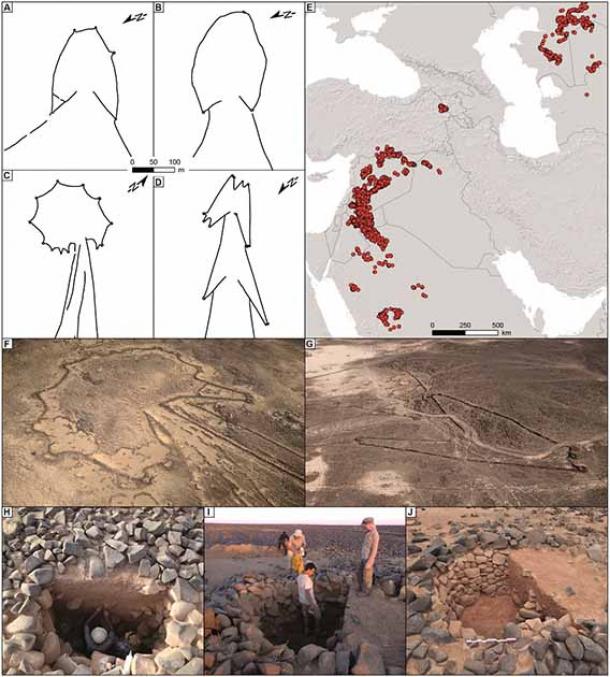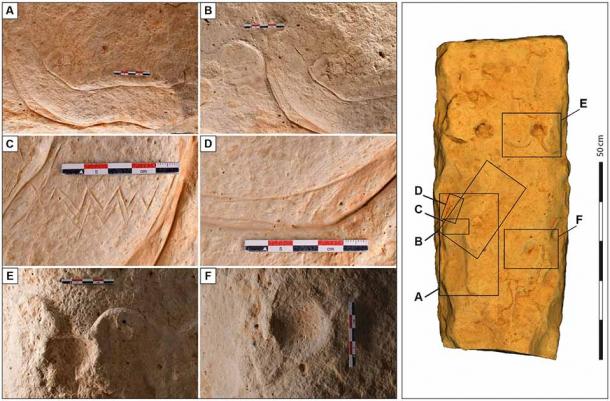
8,000-Year-Old Rock Carvings Are Earliest Scale Diagrams By Prehistoric Architects
While exploring two remote sites on the Arabian Peninsula, an international team of archaeologists found a pair of rocks that each featured a most unique set of engravings. It seems that the stars and lines carved into the surfaces of these rocks depict huge hunting traps that were built in nearby locations by occupants of the region approximately 8,000 years ago. These engraved rocks are the equivalent of prehistoric architectural diagrams, and this is the oldest known example of a scale-plan diagram to have ever been recovered during an archaeological investigation.
The hunting traps in question are spectacular creations known as desert kites. These vast open structures consist of large sections of land surrounded by low stone walls, which are carefully arranged to guide herd animals toward pits or enclosures that could be used to trap them.
Oftentimes the walls would create shapes that resembled diamonds or quadrilaterals with unequal sides when viewed from the air, and after they were first spotted by observers in airplanes 100 years ago they were quickly given the moniker desert kites. These hunting or herding traps can be found primarily in the Middle East and in Central Asia, and more than 6,000 have now been identified from aerial photographs and satellite images.
- The Cult, Pilgrimage, and Herding Past of a Saudi Arabian Mustatil
- Saudi Arabian Dog Remains Are A Shocking Find

Distribution and characterization of desert kites. (SEBAP & Crassard et al. 2023 PLOS One)
Planning the Biggest Hunting Traps Ever Built
In an article just published in the journal PLOS ONE, archaeologists working under the direction of Remy Crassard from the French National Center for Scientific Research (CNRS) report finding the engraved blueprints of desert kites at sites known as Jibal al-Khasabiyeh and Zebel az-Zilliyat in Jordan and Saudi Arabia respectively. These discoveries were made under the auspices of the Globalkites Project, an ongoing study of desert kites that has been exploring the ground around these megastructures searching for artifacts or ruins that might reveal more about their designers and builders.
In Jordan, the Globalkites researchers were delighted by their discovery of a flat rectangular carved stone that was 32 inches (80 centimeters) long and 12.5 inches (32 centimeters) wide. Its imagery is blatantly desert kite-like in appearance, and this amazing relic has been tentatively dated to 5,000 BC.

Detailed photographs of the engraved stone surface from Jibal al-Khashabiyeh, Jordan. (SEBAP & Crassard et al. 2023 PLOS One)
In contrast, the carved rock found in Saudi Arabia was actually a huge boulder, which was approximately 12 feet by seven feet (382 centimeters by 235 centimeters) in size. Its intriguing set of engravings covers virtually the whole of one of the boulder’s sides, and this awe-inspiring work of ancient architectural planning has been dated to the year 6,000 BC.

The engraved boulder, Wadi az-Zilliyat, Saudi Arabia as discovered during rock art survey, view from the north. (SEBAP & Crassard et al. 2023 PLOS One)
Despite the differences in size, both objects accurately depict the designs of desert kites. Adding further evidence to the validity of the connection is the fact that multiple kites have been spotted from the air in both regions where the carved stone blueprints were found.
To make sure their linking of the kites and stone carvings was appropriate, the study authors performed mathematical calculations comparing the geometry of each, using a technique known as geographical graph modeling.
With this methodology, they were able to link the diagram in Jordan to a kite constructed just 1.4 miles (2.3 kilometers) away. They did even better analyzing the diagram from Saudi Arabia, matching it to two nearby kites, one 10 miles (16.3 kilometers) away and another that was just 0.87 miles (1,4 kilometers) distant.
More confirmation of the connection was found in the details of the carvings on the rock faces.
The engraved limestone monolith found at Jibal al-Khashabiyeh in Jordan featured a series of carved lines surrounding a star-shaped enclosure. It also had eight circular depressions carved out, representing pit traps. Interestingly, the carvings on the surface of the rock were not uniform in style, suggesting they may have been the collaborative work of more than one individual.
As for the carvings found on the sandstone boulder at Wadi az-Zilliyat in Saudi Arabia, the imagery was similar to the depiction found in Jordan in some ways and different in others. Stylistically there were clear variations, but this scale model also featured converging lines (the kite walls), a star-shaped enclosure (where animals like gazelles could be herded) and six cup marks (pit traps). In contrast to the design found in Jordan this model actually depicted a pair of aligned kites, which by no coincidence matches the design style used by ancient kite builders working in the area.
Estimates for the ages of the two engravings came from radiocarbon dating tests performed on organic remains found at the real-world kite sites. The researchers assumed the scale models would have been made just before construction began on their real-life parallels.
"The engravings are surprisingly realistic and accurate, and are, moreover, to scale, as observed by the geometric graph-based assessment of shape similarity," the archaeologists wrote in their PLOS ONE study.
"These examples of kite representations are thus the oldest known architectural plans to scale in human history."
Searching for Humanity’s Earliest Architects
What is most remarkable about these discoveries is the intellectual leap required to construct this type of scaled model or design. Creating blueprints that precisely represented megastructures that might be hundreds of feet or meters long on each side demonstrates a breakthrough in intelligent behavior, revealing how carefully and skillfully desert kites were planned out before construction began.
In an email exchange with Live Science, study lead author Remy Crassard noted that ancient desert kite planners may not have always used rock faces to create their scale models. At some locations they may have drawn non-preservable designs in the earth instead, which could explain why stone carving blueprints of these hunting traps have never been found before.
If there are more carved blueprints for ancient kites hidden in remote desert locations, there is a good chance researchers affiliated with the Globalkites Project will eventually find them. The dramatic discoveries at the desert kite sites in Jordan and Saudi Arabia represent one of the most important finds for this ambitious project so far, and now that archaeologists know that such objects might be out there, they will be searching diligently for them from during future explorations.
Top image: Left to Right: Photograph of the engraved stone at the time of discovery at the Jibal al-Khashabiyeh, Jordan location. Sketch of position of plans on the engraved monolith from Jibal al-Khashabiyeh. Location of the engraved rock in Wadi az-Zilliyat, Saudi Arabia. Source: SEBAP & Crassard et al. 2023 PLOS One
By Nathan Falde
















Comments
More likely pre-Ice Age corrals/pens for domesticated animals. The Ice Age, of course, wiped out the animals (along with the entire Atlantean culture) and turned the once lush region into a desert. Then, of course, the stone ruins were later (beginning around 3 or 4k BC) resettled, looted and claimed by a less impressive culture – aka modern man or Sumerian/black-headed tribes.
Nobody gets paid to tell the truth.
Ancient people weren't necessarily stupid? If we haven't worked that out by now, we're the stupid ones.